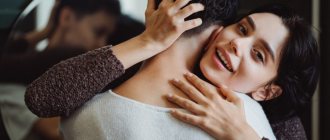Kinesthetic sensations and their role in building body image
- Kinesthetic sensations and their role in building body image
Kinesthetic sensations are sensations of posture, movement of individual parts of the body, caused by excitations coming from proprioceptors located in joints, ligaments and muscles. Thanks to kinesthetic sensations, a person can determine the position and movement of his body parts even with his eyes closed. (cortical centers - in the precentral gyrus) Impulses entering the central nervous system from proprioceptors cause reflex reactions and play a significant role in muscle tone and coordination of movements. Any movement performed is controlled by centripetal impulses from proprioceptors. Loss of kinesthesia leads to a more or less significant disorder of motor coordination, which can be partially corrected by vision. Kinesthesia is generally in close interaction with vision. On the one hand, visual assessment of distances is developed under the control of kinesthetic sensations, on the other hand, visual-motor coordination plays a significant role in our movements performed under the control of vision. In combination with vision, touch, etc., kinesthetic sensations play a significant role in the development of our spatial perceptions and ideas.
Kinesthetic sensations are always involved to some extent in the development of skills. An essential aspect of automation of movements is the transfer of control over their execution from extero to proprioceptors.
Kinesthetic sensations are closely related to the image of the bodily “I” and are of great importance for the awareness of one’s bodily existence.
Kinaesthetic sensations (from the Greek kineo - moving and aisthesis - sensation) are sensations that provide information about the movement and position of one’s own body, arising from irritation of proprioceptors located in the muscles.
Receptors: Ruffini endings are located in muscle tissue, Golgi apparatuses are located in tendons, and muscle capsules are located.
Functions: social and labor development, formation of ways of interaction with the outside world.
Stimulus: stimulation and contraction of a muscle.
Category: contact.
Interaction: tactile, visual
Collected information: reflection of the position of body parts, reflection - analysis of passive movements, especially with static muscle tension, analysis and synthesis of active movements.
Sensations of movement of individual parts of the body, kinesthetic sensations are caused by excitations coming from proprioceptors located in joints, ligaments and muscles.
Thanks to kinesthetic sensations, a person can determine the position and movement of his limbs even with his eyes closed. Impulses entering the central nervous system from proprioceptors as a result of changes that occur during muscle movement cause reflex reactions and play a significant role in muscle tone and coordination of movements.
Every movement we perform is controlled by centripetal impulses from the proprioceptors. The loss of proprioceptive stimuli therefore entails a more or less significant disorder of motor coordination. This lack of coordination can be partially corrected by vision. Kinesthesia is generally in close interaction with vision. On the one hand, visual assessment of distances is developed under the control of kinesthetic sensations; on the other hand, the visual-motor coordination developed in our experience and in practice plays a very significant role in our movements performed under the control of vision. In conjunction with vision, touch, etc. kinesthetic sensations play a significant role in our development of spatial perceptions and ideas.
Kinesthetic sensations are always involved to some extent in the development of skills. An essential aspect of automating movements is the transition of control over their execution from exteroceptors to proprioceptors. Such a transition can occur when, for example, a pianist, having learned a piece of music, ceases to be guided by the visual perception of notes and keyboard, trusting the art of his hand.
- The integrity of the image of perception and the laws of Gestalt.
The integrity of perception is the property of perception, which means that every object is perceived as a stable systemic whole, even if some parts of this whole cannot be observed. Integrity was first studied within the framework of Gestalt psychology. Empirically, two main aspects have been identified: the influence of the whole on the perception of parts and the factors of combining parts into a whole. The main empirical essence of the phenomenon of integrity discovered by Gestaltism refers to the first aspect and lies in the dominance of the integral structure over its individual elements. This dominance manifests itself in different ways:
- The same element, being included in different integral structures, is perceived differently (dual images - an old woman and a girl)
- If you replace individual elements, but maintain the relationships between them, then the overall structure of the image will remain unchanged (melodies in different registers)
- Preservation of the integral structure when its parts fall out (line images)
The general meaning of these forms of dominance is that the specific characteristics of an individual perceptual element are limited in freedom and determined by the place that this element occupies in the general structure of the gestalt. Also in Gestalt psychology, many facts have been accumulated that embody the second aspect: the dependence of grouping methods on the characteristics of the elements themselves. Several factors have been identified...:
- Generality factor: other things being equal, elements are combined into a coherent structure based on the shortest distance between them.
- Closure factor: elements are combined that together make up a closed contour or a closed three-dimensional surface
- Good form factor: elements are combined that generally form a special class of so-called good forms, that is, bodies and figures possessing the properties of symmetry, periodicity, rhythm, etc.
- Collective motion factor: elements that move together
- Uniformity factor: elements with common model or spatial characteristics (same shape, same color)
Thus, in both aspects of the phenomenon of integrity - the dominance of the integral structure of the percept over its individual elements and the factors of combining elements into a whole - the same tendency is manifested to reduce the number of degrees of freedom of individual elements, that is, a decrease in their independence, which leads to a reduction in incoming information.
Integrity of perception - (English wholeness of perception) - a property of perception, consisting in the fact that any object, and especially a spatial objective situation, is perceived as a stable systemic whole, even if some parts of this whole may not be present at the moment. observable (eg the back of an object).
If objectivity characterizes the difference in the type of connection between the elements of the percept within the image of a separate object, on the one hand, and the connections of these intra-subject elements with external background ones, on the other, then integrity expresses the general specificity of the relationship between any elements of the percept and its integral structure.
Gestalt psychology has empirically identified two main aspects that naturally stand out here -
1) the influence of the whole on the perception of parts;
2) factors of combining parts into a whole.
The main empirical essence of the phenomenon of the integrity of the perceptual image discovered by Gestaltism refers to the first aspect and lies in the dominance of the integral structure of the percept over the perception of its individual elements. Experimental material indicates the presence of several different manifestations of such dominance.
The first form of dominance of an integral structure over its elements is expressed in the fact that the same element, being included in different integral structures, is perceived differently. This is clearly demonstrated by the nature of the perception of dual images.
The second form of dominance of the integral structure of the percept over its individual elements is expressed in the fact that if individual elements are replaced, but the relationships between them are preserved, then the overall structure of the image remains unchanged.
Experiments reveal several factors or empirical laws of such grouping of elements into a coherent structure. These factors are the following:
- The proximity factor. All other things being equal, elements are combined into a coherent structure based on the smallest distance between them.
- Factor of isolation. The elements that together constitute a closed contour or a closed three-dimensional surface are combined into a single perceptual structure.
- Good form factor. The elements that are combined are those that form as a whole a special preferred class of so-called good shapes, such as a circle or a straight line, i.e. bodies or figures that have the properties of symmetry, periodicity, rhythm, etc.
- Factor of collective movement. Elements that move together (a flock of birds, a squadron of airplanes, etc.) tend to form a group.
- The factor of homogeneity, which consists in the fact that the determinant of the combination of elements is their common spatial or modal characteristics; a single group includes components of the same shape, the same color, etc.
Laws of Gestalt.
Gestalt - (German gestalt - form, structure) is the basic concept in Gestalt psychology, acting as a unit of analysis of consciousness and psyche, which denotes holistic formations of consciousness, irreducible to the sum of their parts.
The term was proposed by Gestalt psychology and stands among its basic concepts. Initially applied to the description of the psyche, but later extended to the area of physical, physiological, social and other phenomena. The concept of gestalt originated in the study of sensory formations, when it was necessary to distinguish the way they are structured from the individual components (sensations) that comprise them (for example, although a melody when performed in different keys causes different sensations, it is recognized as the same). This method came to be understood as Gestalt. Otherwise, it means holistic formations of consciousness, irreducible to the sum of their parts: apparent movement, insight, perception of melody, etc. Gestalt psychology has put forward the study of the laws of Gestalt as its main task. Among the laws of Gestalt the following were highlighted:
1) the attraction of parts to form a symmetrical whole;
2) grouping these parts in the direction of maximum simplicity, proximity, balance;
3) pregnancy - the tendency of each mental phenomenon to take a more definite, distinct and complete form.
The main signs of kinesthetics
Even with a very good understanding of who a kinesthetic person is and what behavioral features are characteristic of him, it is quite difficult to identify a person with this type of perception. Often he himself is not aware of his peculiarity, let alone recognizing him by external signs and habits. And yet it is possible, although this will require communicating with the person often and regularly. Let's look at some of the most obvious signs that identify people who have a predominant kinesthetic type of perception:
- Characteristic words. Since bodily sensations are important to a kinesthetic learner, he often talks about these feelings. His phrases constantly contain the words “soft”, “warm”, “rough”, “silky”, “hot”, “felt” - those that convey certain sensations.
- Pay attention to air temperature and other conditions. Kinesthetic people are sensitive to discomfort. They are the first to notice that the room is cold, hot or stuffy. Strong smells can distract them, making it difficult to concentrate. Therefore, they do not like it when someone in the office has a snack at work.
- Gestures and touches in communication. Communication with loved ones, friends and acquaintances is important for any person. This is not just an exchange of information, but also an exchange of emotions. Therefore, kinesthetic learners, when communicating, gesticulate very actively and often unobtrusively touch the interlocutor (which should not be taken at all as flirting). When they see an interesting object, they try to touch it instead of looking at it.
- Orderly arrangement of things. Kinesthetic learners do not like chaos in the workplace or in personal belongings, since it is more difficult for them to visually find the necessary objects. Therefore, he prefers to know where everything is.
- Restrained behavior. In society, such people behave calmly, often looking immersed in thoughts or their own experiences.
- Profession, hobbies and interests. Pay attention to what a person does, what he is interested in and how he relaxes. If he works as a massage therapist, in his free time he sculpts sculptures from alabaster or collects models, and prefers to relax on the dance floor - you are probably a kinesthetic person.
- Comfortable and practical clothes. As noted above, kinesthetic learners value comfort. Therefore, when choosing clothes, they are guided by considerations of convenience and practicality, completely not understanding why style and compliance with fashion trends are so important for others.
Interestingly, kinesthetic learners are often hyperactive in childhood, but with age they usually become much calmer. From the outside they often look like introverts, but this is not entirely true. They are not withdrawn, they just communicate more calmly than other people. It is often important for them that a loved one simply be nearby, since they feel his presence literally on a physical level.
Physiological mechanism of sensations
The process of the emergence of sensations can be represented as follows. An irritant (music) with certain characteristics affects a certain sense organ (ears), which perceives information and transmits it along conductive pathways to the brain, where this information is processed, and we begin to hear music. This is how the surrounding world is reflected.
Charles Sherrington, an English physiologist, Nobel Prize laureate in physiology or medicine, proposed a classification of sensations according to the nature of reflection and location of receptors.
Psychological portrait of a kinesthetic learner
To better understand who a kinesthetic person is and how best to behave with him, it is advisable to understand the characteristics of his psyche. Psychologists identify several character traits characteristic of people with this type of perception:
- Impulsiveness. Despite the characteristic calmness in communication, the kinesthetic person often begins to act without thinking through the consequences and without drawing up any plan. At the same time, he values stability, so he chooses those paths that seem to him the least risky.
- Non-conflict. Emotions for kinesthetics are comparable to physical feelings, and any conflict that may seem like a harmless showdown to other people causes them pain. Therefore, they try to avoid conflicts, and they do this very skillfully.
- Silence. Kinesthetic people speak little, which is why they seem modest and timid to others. In fact, they are simply not very talkative, and when communicating, communication is more important to them than communication.
- Melancholy. This does not mean that all kinesthetic people are melancholic. They are simply so immersed in their thoughts and feelings that they literally do not notice the events happening around them.
- Conservative. People with this type of perception do not like to rebel against established traditions. They prefer the world around them to be as predictable as possible.
It cannot be said that the listed features make a person better or worse for others. You just need to understand and take them into account, in particular, so as not to be offended that your kinesthetic friend did not notice your new hairstyle or the stylishly folded handkerchief in your pocket. But he is a very peace-loving, flexible and reliable person with whom you can build harmonious friendships or romantic relationships.
Kinesthetic woman
Women with a kinesthetic type of perception love to attend various relaxing procedures. They like massages and jacuzzi, they like to spend time in hairdressers or nail salons, and they do not do it for the sake of beauty. just like the tactile sensations associated with these procedures. Therefore, they always have well-groomed skin, nails and hair.
Usually such ladies have good relationships on the personal front, since they are always very affectionate and gentle with their partner. They never forget to hug and kiss him, willingly give him a massage, and pay great attention to caressing his body. Another advantage in relationships with women who have kinesthetic perception is that they do not disperse their attention to the men around them . They wear simple and comfortable clothes and avoid fashionable outfits and bright makeup.
Content
- Physiological mechanism of sensations
- Types of sensations according to Sherrington
- Properties of sensations
- Sensitivity thresholds
- Sensory disorders
- Adaptation, synesthesia, sensitization
Sense organs are organs that perceive and partially process information that can come from both outside and inside. There are 5 main sense organs: eyes, nose, skin, ears, tongue.
Visual sensations
With the help of the eyes, a person receives 80-90% of information about the world around him. Visual sensations arise when light rays act on the nerve cells of the retina. Rods (130 million) are located on the periphery of the retina; they are responsible for distinguishing between black, white, and gray at any time of the day. Cones (7 million) are located in the center and are responsible for distinguishing color. The mechanism for creating visual sensations: the stimulus acts on the nerve cells of the retina of the eye, excitation occurs, which is transmitted along the pathways to the corresponding part of the brain.
Olfactory sensations
The sense of smell is one of the most ancient and important senses from an evolutionary point of view. Many animals use these sensations to navigate in space, defend themselves from attacks, communicate, choose partners, etc. Olfactory sensations are caused by particles of a substance that fall on the nasal mucosa.
Tactile sensations
Nerve fibers located in every area of the skin send signals to the brain about temperature fluctuations, touch, and pain. The skin perceives vibration, temperature, electrical, chemical, and mechanical irritations.
Auditory sensations
Auditory sensations are caused by auditory waves, i.e. air vibrations from a sound source. The human hearing range is 16-20,000 vibrations per second (16 Hz-20 kHz), higher frequencies are ultrasound, lower frequencies are infrasound. 1000 vibrations per second is normal.
Taste sensations
During taste sensations, particles of objects affect the mucous membrane of the tongue. There are 4 basic tastes: sour, bitter, sweet, salty. The tongue is conventionally divided into several zones, each of which perceives its own type of taste.
Sometimes the vestibular apparatus in the inner ear (sense of balance and sensation in space), as well as muscles, tendons, ligaments (changes in the position of individual parts and the entire body in space, determination of the mass and volume of objects, analysis of movements and their coordination) are added to this list.
Male kinesthetic
Men with a kinesthetic type of perception attach little importance to appearance, both their own and that of others. And yet, when choosing a companion, they pay attention to the shape of her body, skin and hair, since touch is very important to them. At the same time, they prefer ladies who do not overuse cosmetics and perfume, but who are neat and well-groomed.
Such men don’t care much about their own appearance, not trying to look bright and stylish. They prefer simple and comfortable haircuts, most often either clean-shaven or growing a neat beard that does not require complex care and does not cause inconvenience. They prefer clothes that are comfortable and practical, because they are not ready to sacrifice their own comfort for the sake of a stylish look. Kinesthetic men are quite talkative and like to talk about feelings.











